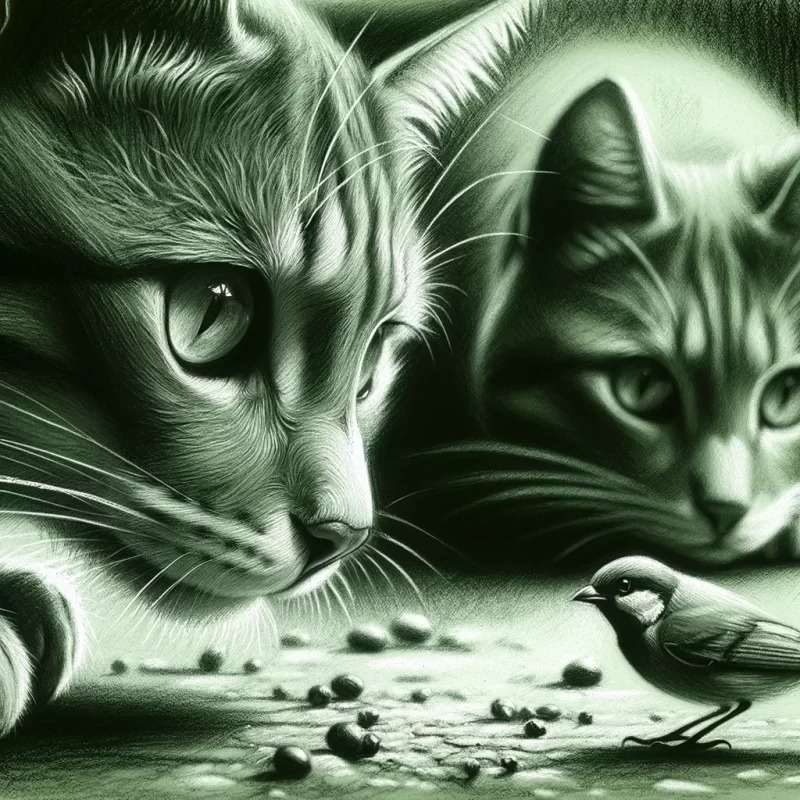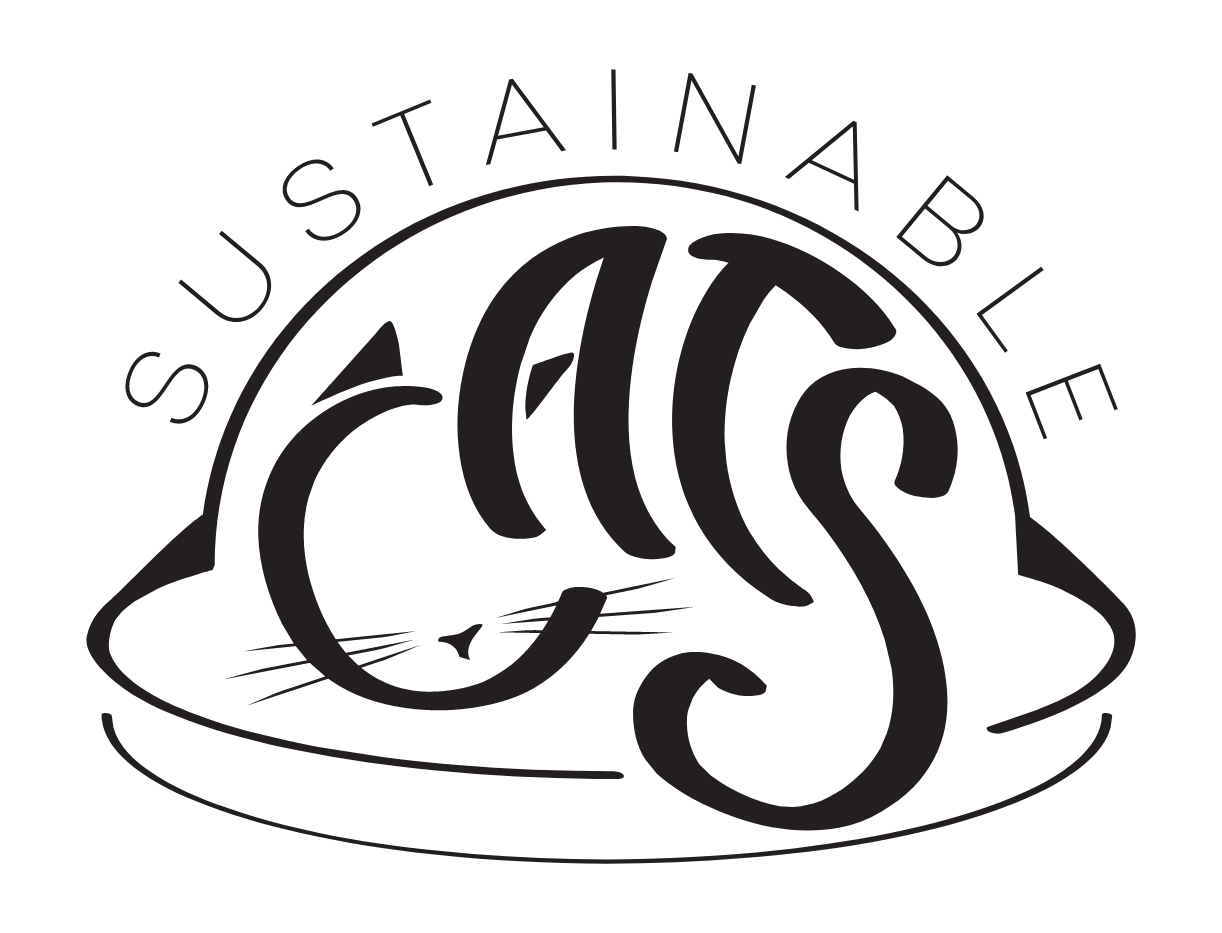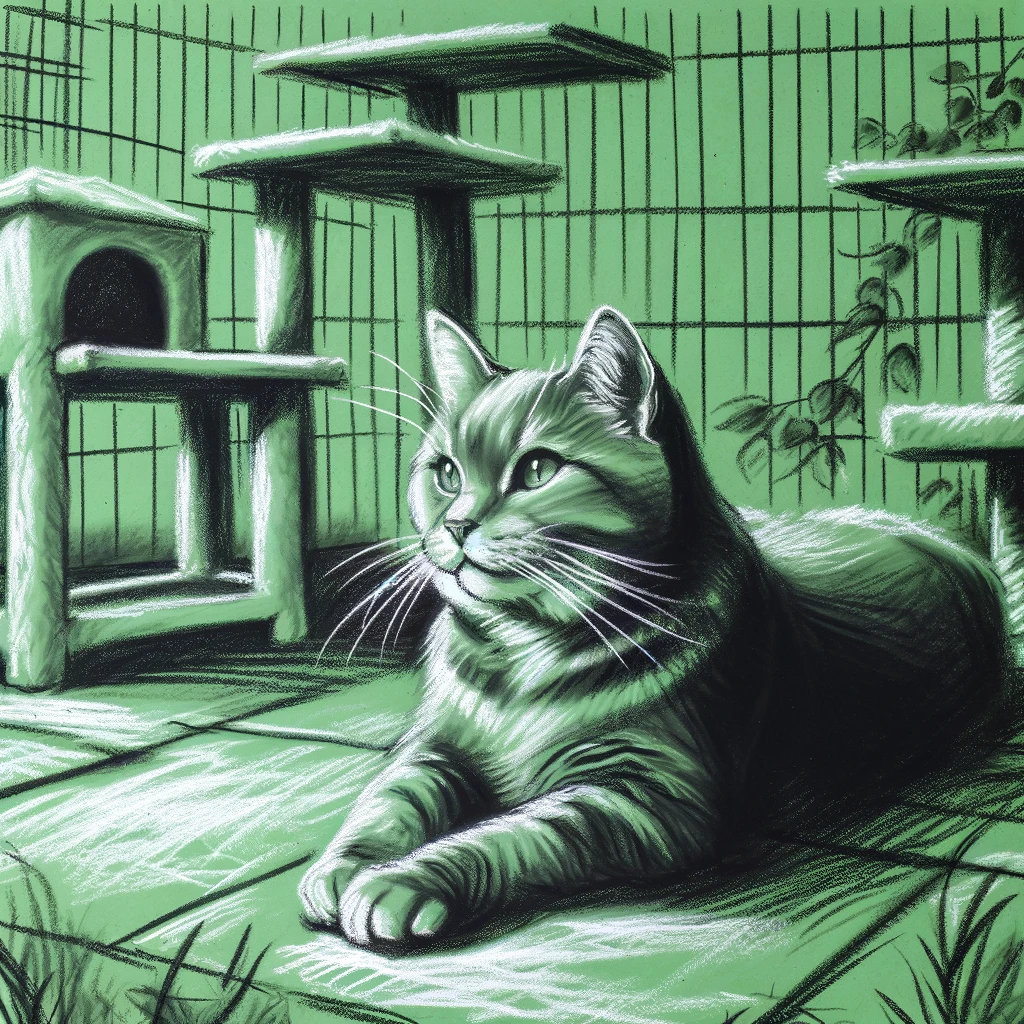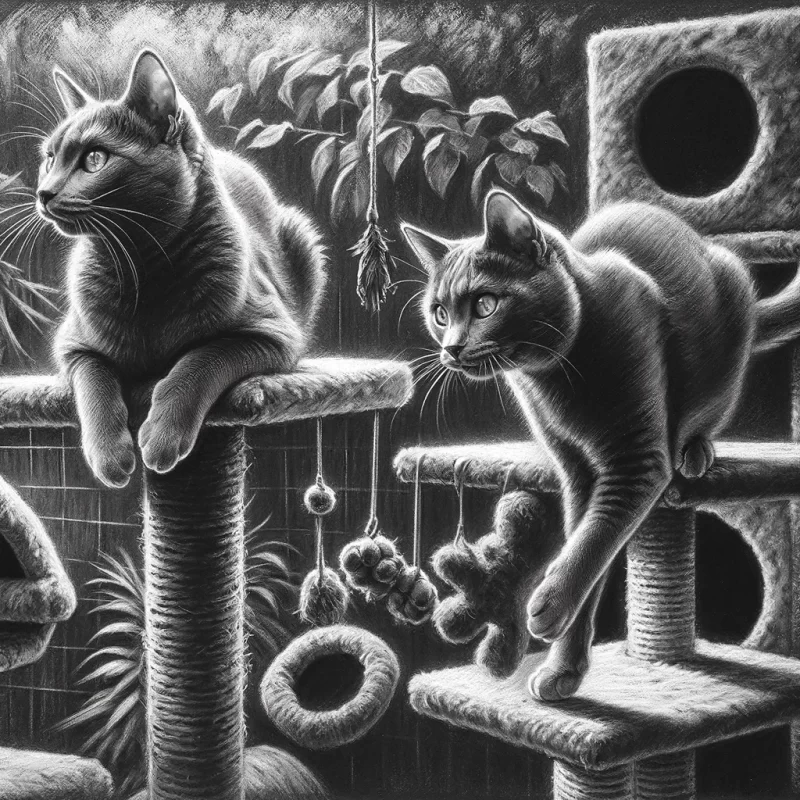The outdoor cat enclosure offers a safe haven for your feline friend, allowing them to enjoy nature without the dangers of the outdoor world. Additionally, these structures contribute to environmental sustainability.
As a cat owner, you want to provide the best possible environment for your feline companion. While cats love the freedom of exploring the great outdoors, keeping them safe from dangers such as traffic, predators, and exposure to harmful substances is essential. This is where a particular type of playpen, the outdoor cat enclosure, comes into play.
What are Outdoor Cat Enclosures?
Outdoor cat enclosures, or catios or cat patios, are secure structures that allow your cat to enjoy the outdoors while remaining protected. These enclosures are designed to provide a safe and stimulating environment for your cat, allowing them to experience nature’s sights, sounds, and smells without the risks associated with unrestricted outdoor access.
The Sustainability of Cat Enclosures
In addition to providing a safe and enriching environment for your cat, outdoor cat enclosures also contribute to the sustainability of our environment. Keeping your cat contained within a designated outdoor space can help minimise their impact on the local ecosystem.
Cats are natural hunters, and when left to roam freely, they can significantly impact local wildlife populations. They may prey on birds, small mammals, and other creatures, disrupting the ecosystem’s delicate balance. By confining your cat to an outdoor enclosure, you can prevent them from hunting and reduce their potential impact on native wildlife.
Furthermore, outdoor cat enclosures can also help minimise the risk of your cat being exposed to and spreading diseases to other animals. By keeping them within a controlled environment, you can prevent them from encountering sick or infected animals, reducing the risk of transmission.
By providing your cat with an outdoor enclosure, you make a sustainable choice that benefits your cat and the environment. It allows your cat to enjoy the outdoors while minimising their impact on local wildlife and reducing the risk of disease transmission. We can create a harmonious balance between our feline companions and the natural world.
How are Outdoor Cat Enclosures Made?
Outdoor cat enclosures can be constructed in various ways, depending on your available space, budget, and personal preferences. Some enclosures are standalone structures, while others can be attached to existing structures like windows, balconies, or porches. The materials used for construction can range from wood and wire mesh to PVC pipes and netting, ensuring durability and security.
The design of an outdoor cat enclosure typically includes multiple levels, platforms, ramps, and perches to provide vertical space for climbing and lounging. Access points such as doors or windows are incorporated to allow easy entry and exit for your cat. Additionally, the enclosure may include scratching posts, toys, and hiding spots to stimulate your cat mentally and physically.
Why are They Called Catios or Cat Patios?
The terms “catios” and “cat patios” are often used interchangeably to refer to outdoor cat enclosures. These names highlight the concept of creating a safe and enjoyable outdoor space specifically designed for cats. The word “catio” is a combination of “cat” and “patio,” emphasising the idea of a cat-friendly patio area. Similarly, “cat patio” conveys the notion of a dedicated outdoor space where cats can relax and explore.
By providing your cat with a catio or cat patio, you are allowing them to experience the outdoors in a controlled and secure manner. These enclosures offer numerous benefits for you and your feline companion, ensuring their safety, happiness, and overall well-being.
In the following chapters, we will delve deeper into the benefits of outdoor cat enclosures, explore different types of enclosures, and provide tips on creating the perfect outdoor sanctuary for your beloved cat. Let’s embark on this journey together and find answers to the most pressing outdoor cat enclosure-related questions!
What materials are best for building an outdoor cat enclosure?
When building an outdoor cat enclosure, it is important to select materials that are durable, weather-resistant, and safe for your feline friend.
Pressure-treated wood is one of the most commonly used materials for outdoor cat enclosures. This type of wood is resistant to rot and decay, making it suitable for outdoor use. However, ensuring the wood is treated with non-toxic chemicals that are safe for cats is essential.
Another option is galvanised steel mesh. This material is strong and provides a secure enclosure for your cat. Choosing a mesh with small openings is essential to prevent your cat from escaping or getting injured.
Additionally, vinyl-coated wire mesh is a popular choice for outdoor cat enclosures. This material is corrosion-resistant and offers excellent visibility for your cat. Selecting a wire mesh that is small enough to prevent your cat from squeezing through is essential.
For the flooring of the enclosure, consider using concrete or paving stones. These materials are easy to clean and prevent your cat from digging or burrowing.
To protect your cat from the elements, consider using UV-resistant polycarbonate sheets or clear corrugated roofing panels for the enclosure’s roof. This provides shelter from rain, wind, and excessive sunlight while allowing natural light to enter.
Finally, use non-toxic and pet-safe paint if you paint any wooden surfaces. This will help protect the wood from weather damage and ensure your cat’s safety.
By selecting these suitable materials, you can confidently build an outdoor cat enclosure that is safe and comfortable for your furry friend.
How big should an outdoor cat enclosure be for multiple cats?
When considering the size of an outdoor cat enclosure for multiple cats, it is essential to provide enough space to accommodate the needs and activities of each cat. The enclosure should allow for adequate stretching, climbing, and exploration to ensure the cats’ well-being.
The recommended size for an outdoor cat enclosure for multiple cats is a minimum of 50 square feet (4.6 square meters). However, it is ideal to provide even more space. The additional space allows the cats to engage in their natural behaviours, such as chasing, playing, and hiding. It also helps to prevent potential conflicts among the cats, as they can establish their territories and have enough room to retreat if needed.
To maximise the space within the enclosure, consider adding vertical elements like perches, shelves, and climbing structures. These allow the cats to observe their surroundings from different heights and create additional living areas within the enclosure.
Additionally, ensure the enclosure has plenty of hiding spots, such as covered areas, tunnels, and cosy dens. These spaces give the cats a sense of security and privacy, reducing stress and promoting their overall well-being.
Remember to regularly assess the enclosure size based on the number and specific needs of the cats. Some cats may require more space or have different activity levels, so it is important to adapt the enclosure accordingly to ensure their comfort and happiness.
How can I make my outdoor cat enclosure escape-proof?
When it comes to making your outdoor cat enclosure escape-proof, you can take several steps to ensure your feline friend’s safety and security. Follow these guidelines to create a secure environment for your outdoor cat:
- Secure the perimeter: Start by ensuring that the perimeter of the enclosure is fully enclosed. Use sturdy materials like heavy-duty mesh or wire fencing to prevent gaps or openings through which your cat could squeeze or claw their way out.
- Reinforce the structure: Regularly inspect the enclosure for any weak spots or areas needing reinforcement. Strengthen any weak points, such as loose panels or mesh, to prevent your cat from breaking through or creating an escape route.
- Consider the height: Cats are excellent climbers and jumpers, so it’s essential to consider the height of the enclosure walls. Ensure the walls are tall enough to prevent your cat from jumping over them. Consider adding a roof or a netting system to avoid any vertical escapes.
- Install a secure door: Pay careful attention to the design and construction of the enclosure door. Ensure that it’s made of sturdy materials and that it closes securely. Consider adding a latch or lock mechanism to prevent accidental door openings or forced escapes.
- Block any potential escape routes: Inspect the surrounding area and identify possible routes. Block off access to trees, fences, or neighbouring structures that your cat could use as a launching point to escape from the enclosure.
- Eliminate climbing aids: Remove any nearby objects, such as furniture, ladders, or plants, that could allow your cat to climb or jump out of the enclosure.
- Provide mental and physical stimulation: A satisfied and mentally stimulated cat is less likely to attempt to escape. Ensure your cat’s enclosure has plenty of toys, scratching posts, perches, and hiding spots to keep them entertained and content. Remember, even with a secure outdoor cat enclosure, it’s essential to supervise your cat during their outdoor time to ensure they remain safe and protected. Regularly inspect and maintain the enclosure to address potential vulnerabilities and keep your cat enjoying their outdoor space happily.

What are some must-have features for an outdoor cat enclosure?
When designing an outdoor cat enclosure, several must-have features can enhance the safety, comfort, and overall well-being of your feline friend. These features include:
- Secure Enclosure: A secure enclosure is essential to protect your cat from potential predators and prevent them from escaping. It should have a sturdy perimeter with netting or mesh that is cat-proof and resistant to chewing or clawing.
- Sheltered Areas: Providing sheltered areas within the enclosure is essential to offer protection from harsh weather conditions, such as rain, wind, or excessive sunlight. This can be in the form of covered sections or tiny cat houses where cats can retreat when they need privacy.
- Climbing Structures: Cats love to climb and explore their surroundings. Including various climbing structures, such as ramps, shelves, or cat trees, allows them to exercise and satisfy their instincts. Incorporating different heights and levels will provide mental stimulation and opportunities for your cat to relax and observe their surroundings.
- Sunning Perches: Cats enjoy basking in the sun and soaking up its warmth. Including elevated sunning perches or platforms in sunny areas of the enclosure will give your cat a cosy spot to lounge, nap, and enjoy the outdoors.
- Litter Box Area: It is crucial to allocate a specific space within the enclosure for a litter box. This helps maintain good hygiene, prevents odour, and ensures your cat has a designated spot to relieve themselves. Consider using a covered litter box or a box with a hood to provide privacy.
- Enrichment Opportunities: Incorporate various enrichment options within the enclosure to keep your cat mentally and physically stimulated. This can include toys, scratching posts, puzzle feeders, or interactive play areas. These activities will help prevent boredom and encourage exercise.
- Easy Access Points: Ensure the enclosure has multiple access points for your cat to enter and exit quickly. This can include secure cat-sized doors or tunnels that allow them the freedom to come and go as they please. Every cat is unique, so consider your cat’s specific needs and preferences when designing the outdoor enclosure. By creating a safe and enriching environment, you can provide your cat with a beautiful outdoor experience while keeping them protected.
How can I keep my outdoor cat enclosure clean and sanitary?
It is important to maintain a clean and sanitary environment for your outdoor cat enclosure to ensure the well-being and health of your feline companion. Here are some tips to help you keep the enclosure clean:
- Regular Cleaning: Schedule regular cleaning sessions to remove accumulated dirt, debris, and waste. Use a broom or brush to sweep the floor and walls, and consider using a vacuum cleaner for more thorough cleaning.
- Disinfecting: After removing debris, use a pet-safe disinfectant to clean the surfaces of the enclosure. This will help eliminate any bacteria or viruses that may be present. Follow the instructions on the disinfectant for proper usage and dilution.
- Litter Box Maintenance: If your cat uses a litter box in the enclosure, scoop it daily to remove waste. Replace the litter regularly to prevent odour buildup, and wash the litter box with soap and water when needed.
- Odour Control: To keep the enclosure smelling fresh, consider using pet-safe odour control products or natural remedies. You can sprinkle baking soda in the litter box or place activated charcoal near areas prone to odour.
- Pest Prevention: Regularly check the enclosure for any signs of pests, such as fleas or ticks. If you notice any infestation, consult your veterinarian for appropriate pest control measures that are safe for your cat.
- Water and Food Bowls: Clean and refill your cat’s water and food bowls regularly to prevent contamination. Replace any damaged or dirty bowls to maintain a hygienic eating and drinking area for your cat.
- Shelter Maintenance: If your cat enclosure has a shelter or sleeping area, ensure it is clean and comfortable. Inspect the bedding materials regularly and replace them as needed. Wash removable bedding in hot water to kill any parasites or bacteria. Regular maintenance and cleaning are essential for a healthy and sanitary outdoor cat enclosure. By following these tips, you can provide a clean and safe environment for your beloved cat to enjoy the outdoors while staying protected.
Are there any potential dangers to consider when building an outdoor cat enclosure?
When building an outdoor cat enclosure, it is essential to consider potential dangers that could affect the safety and well-being of your feline companion. Here are some key points to keep in mind:
- Predators: One of the main concerns is the presence of potential predators such as coyotes, foxes, or even other aggressive animals in your area. Your enclosure should be designed to prevent unauthorised access from these animals.
- Escaping: Cats are natural climbers and escape artists. Ensure that the enclosure is constructed to prevent your cat from climbing or jumping over the walls. Use materials that are sturdy and tall enough to discourage escape attempts.
- Toxic plants: Some plants in your outdoor area may be toxic to cats if ingested. Researching and identifying potentially harmful plants within and around the enclosure is important. Remove poisonous plants or create barriers to keep your cat away from them.
- Harsh weather conditions: Extreme temperatures, heavy rain, or strong winds can harm your cat’s health. Ensure the enclosure provides adequate shelter and protection from the elements. Provide options for shade and ensure proper ventilation for comfort.
- Harmful substances: Outdoor areas may contain chemicals, pesticides, or other dangerous substances. Keep your cat away from these by ensuring they are not accessible within or around the enclosure. Store these substances in secure locations.
- Disease transmission: Outdoor environments can increase the risk of exposure to diseases, parasites, and infections. Ensure your cat is up to date on vaccinations and use preventive measures to minimise contact with stray or wild animals.
- Secure fencing and gates: Ensure that the fencing around the enclosure is secure and properly latched. Regularly inspect the enclosure for any weaknesses or damage that could compromise its integrity. By considering these potential dangers and taking appropriate measures, you can create a safe and secure outdoor cat enclosure that provides your feline companion with the enrichment of the outdoors while minimising risks to their health and safety.
Can I incorporate climbing structures or perches into my outdoor cat enclosure?
Incorporating climbing structures or perches into your outdoor cat enclosure can significantly enhance your feline friend’s experience and overall well-being. Cats are natural climbers, and providing them with opportunities to climb and perch not only simulates their natural behaviour but also offers numerous benefits.
Climbing structures, such as cat trees, shelves, or platforms, allow cats to exercise their instincts to climb and explore their environment. These structures provide vertical space, which is particularly valuable in smaller enclosures with limited horizontal space. Cats can climb, jump, and navigate various levels, promoting physical exercise, muscle tone, and balance.
Furthermore, climbing structures can serve as elevated vantage points, giving your cat a sense of security and satisfaction. Cats often enjoy observing their surroundings from higher ground, allowing them to monitor their territory and feel more in control. This elevated position can also provide a safe space for your cat to retreat when they need some alone time or want to observe from a distance.
Perches or resting spots can also be incorporated into your cat enclosure. These elevated areas provide comfortable and cosy spaces where your cat can relax, lounge, or nap in the fresh air. Perches can be in hammocks, padded shelves, or even window perches, allowing cats to bask in the sunlight while observing the outside world.
When incorporating climbing structures or perches, it’s essential to consider the materials’ size, durability, and safety. Ensure that the structures are sturdy and securely attached to prevent accidents or collapses. Avoid using materials that may splinter or pose any hazards to your cat’s health.
Providing climbing structures and perches in your outdoor cat enclosure enriches your cat’s environment and promotes their physical and mental well-being. These additions enhance their daily activities, offer mental stimulation, and help satisfy their instincts to climb, explore, and observe.
How can I provide shelter for my outdoor cats in the enclosure?
When providing shelter for outdoor cats in an enclosure, there are a few key factors to consider.
First and foremost, the shelter should be insulated and weatherproof to protect the cats from the elements. This means using durable materials that can withstand rain, wind, and extreme temperatures.
One popular option for outdoor cat enclosures is a specially designed cat house or cat shelter. These structures are typically made of sturdy materials such as wood or PVC and feature insulation to keep the cats warm in cold weather and cool in hot weather. They may also have a roof that can be opened for easy cleaning and placement of bedding.
Providing adequate bedding inside the shelter is essential to keep the cats comfortable. This can include blankets, straws, or specially designed cat beds that provide insulation. Regularly check and replace the bedding to keep it clean and dry.
In addition to shelter, providing the cats with access to fresh water and food in their enclosure is essential. Consider placing a water bowl and food dish in a protected area of the enclosure, away from wind and rain. You can also consider using heated water bowls or outdoor cat feeders that help prevent freezing in cold weather.
Creating a cosy and safe space for outdoor cats in the enclosure is essential for their well-being. You can ensure they are protected and comfortable in their outdoor home by providing a weatherproof shelter, comfortable bedding, and access to food and water.

Are there any plants or landscaping features that are safe to include in an outdoor cat enclosure?
Several plants and landscaping features are safe to include in an outdoor cat enclosure. When selecting plants, it is important to consider the safety of your feline friends, as some plants can be toxic to cats if ingested. Here are some cat-friendly options:
- Catnip (Nepeta cataria): Catnip is a cat’s favourite and can be grown indoors and outdoors. Its aromatic leaves and purple flowers will attract your cats and provide them with hours of enjoyment.
- Cat grass (Dactylis glomerata): Cat grass is another popular choice for outdoor enclosures. It is safe for cats to chew on and helps aid digestion. Growing cat grass in your enclosure will provide your cats with a natural source of greens.
- Valerian (Valeriana officinalis): Valerian is a herb known for its calming effects on cats. Many cats are attracted to the scent of valerian, making it a great addition to your outdoor enclosure.
- Spider plant (Chlorophytum comosum): Spider plants are non-toxic to cats and add a pop of green to your enclosure. Cats may be tempted to play with the dangling leaves, providing entertainment. When it comes to landscaping features, consider incorporating the following:
- Climbing structures: Cats love to climb and explore their surroundings. Install shelves, perches, or cat trees within the enclosure to provide vertical space for your cats to climb and observe their surroundings.
- Hiding spots: Create cosy hiding spots within the enclosure using cat-friendly materials like straw, blankets, or cat igloos. These spots will give your cats a sense of security and privacy.
- Scratching posts: Provide scratching posts or mats within the enclosure to fulfil your cat’s natural scratching instincts. This will help keep their claws healthy and prevent them from damaging other objects in the enclosure.
- Toys and play areas: Incorporate interactive toys and play areas within the enclosure to keep your cats active and engaged. Add tunnels, balls, or feather toys to stimulate their hunting instincts. Remember to regularly check and maintain the plants and landscaping features in your outdoor cat enclosure to ensure they are in good condition and pose no risk to your cats. Consulting with a veterinarian or pet expert can also provide valuable guidance on creating a safe and enriching outdoor environment for your feline companions.
How can I make my outdoor cat enclosure weatherproof?
Making your outdoor cat enclosure weatherproof is essential to ensure the comfort and safety of your cat. Here are some steps you can take to achieve this:
- Start with a suitable enclosure: Ensure your cat enclosure is made of sturdy and weather-resistant materials such as durable mesh or solid walls. This will provide a solid foundation for making it weatherproof.
- Seal any gaps or openings: Inspect the enclosure thoroughly for any gaps, holes, or openings that may allow rain, snow, or wind to enter. Use weather-stripping or caulk to seal these areas, ensuring a tight and secure enclosure protected from the elements.
- Install a waterproof roof: A waterproof roof is crucial for protecting your cat from rain and snow. Consider using polycarbonate panels or heavy-duty tarps to create a water-resistant cover. Ensure that the roof is securely attached to the enclosure and sloped to allow water to drain off properly.
- Provide adequate insulation: Insulating the enclosure will help regulate the temperature and keep your cat warm during colder months. Consider adding insulation materials such as foam boards or blankets to the walls and roof of the enclosure. Avoid using toxic insulation materials that may be harmful to your cat.
- Elevate the flooring: Elevating the flooring of the enclosure can prevent moisture from seeping in. Use materials such as tiles, elevated platforms, or gravel that allow water to drain away, keeping the interior dry and comfortable for your cat.
- Add a windbreak: Strong winds can make the enclosure uncomfortable for your cat. Consider installing windbreaks, such as solid panels or wind-resistant mesh, on the sides of the enclosure facing the prevailing wind direction. This will provide protection and create a more pleasant environment for your cat.
- Provide adequate ventilation: While keeping the enclosure weatherproof, it is also essential to ensure proper ventilation. Install vents or mesh panels to allow for fresh air exchange without compromising the enclosure’s weatherproofing.
- Regular maintenance: Regularly inspect and maintain the weatherproofing of the enclosure. Check for any signs of wear and tear, loose seals, or damage caused by weather conditions. Repair or replace any damaged components promptly to maintain the enclosure’s effectiveness. By following these steps, you can make your outdoor cat enclosure weatherproof, providing a comfortable and safe environment for your cat to enjoy the outdoors while staying protected from the elements.
Go Ahead and Create a Sustainable and Enriching Outdoor Space for Your Cat
In conclusion, outdoor cat enclosures, also known as catios or cat patios, offer a fantastic solution for cat owners who want to provide their feline companions with a safe and stimulating outdoor experience. These DIY or custom-built enclosures allow your cat to have the freedom to run, climb stairs, and explore while remaining protected from potential dangers.
Not only do outdoor cat enclosures prioritise your cat’s safety, but they also contribute to the sustainability of our environment. Confining your cat within a designated outdoor space can minimise their impact on local wildlife populations and reduce the risk of disease transmission. This sustainable approach ensures that your cat can enjoy the outdoors without disrupting the ecosystem’s delicate balance.
Moreover, outdoor cat enclosures serve as a source of enrichment for your cat. With multiple levels, platforms, and hiding spots, these enclosures provide opportunities for climbing, lounging, and observing the surrounding environment. You can further enhance your cat’s mental and physical well-being by incorporating scratching posts, toys, and other interactive elements.
Whether you build a DIY enclosure or opt for a custom design, creating an outdoor space for your cat is rewarding. It allows you to provide your feline companion with the best of both worlds – the freedom to experience the outdoors and the safety and security they need.
Incorporating an outdoor cat enclosure into your cat’s life ensures their safety and happiness and promotes sustainability and responsible pet ownership. So, why wait? Start planning and building your cat’s outdoor sanctuary today, and witness the joy and contentment it brings to your beloved feline friend.












